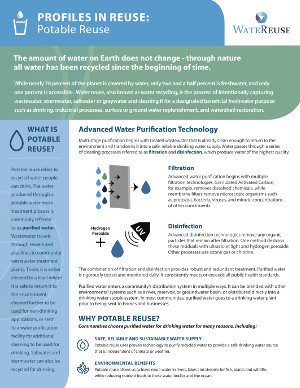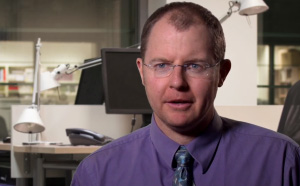Potable Reuse
Potable reuse refers to recycled water people can drink. The water produced through a potable water reuse treatment process is commonly referred to as purified water. Wastewater travels through sewers and pipelines to community wastewater treatment plants. There, it is either cleaned to a level where it is safe to return it to the environment, cleaned further to be used for non-drinking applications, or sent to a water purification facility for additional cleaning to be used for drinking. Saltwater and stormwater can also be recycled for drinking.
Why Potable Reuse?
Communities choose purified water for drinking water for many reasons, including:
- Safe, Reliable, and Sustainable Water Supply: Potable reuse uses proven technology to purify recycled water to provide a safe drinking water source that is independent of climate or weather.
- Environmental Benefits: Potable reuse allows us to leave more water in rivers, lakes and streams for fish, plants and wildlife, while reducing nutrient loads to these water bodies and the ocean.
Advanced Water Purification Technology
Multi-stage purification begins with treated wastewater that is already clean enough to return to the environment and transforms it into a safe, reliable drinking water supply. Water passes through a series of cleaning processes referred to as filtration and disinfection, which produce water of the highest quality.
Filtration
Advanced water purification begins with multiple filtration technologies. Granulated Activated Carbon, for example, removes dissolved chemicals, while membrane filters remove microscopic organisms such as protozoa, bacteria, viruses, and minute concentrations of other constituents.
Disinfection
Advanced disinfection technologies remove any organic particles that remain after filtration. One method destroys these residuals with ultraviolet light and hydrogen peroxide. Other processes use ozone gas or chlorine.
The combination of filtration and disinfection provides robust and redundant treatment. Purified water is rigorously tested and monitored daily. It consistently meets or exceeds all public health standards.
Purified water enters a community’s distribution system in multiple ways. It can be blended with other environmental systems such as a river, reservoir, or groundwater basin, or distributed directly into a drinking water supply system. In most communities, purified water goes to a drinking water plant prior to being sent to homes and businesses.
Profiles in Reuse: Potable Reuse

Expert Voices

Watch Expert Voices
